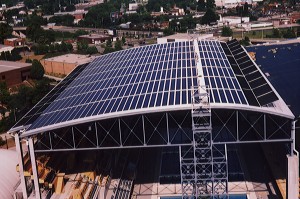Subsidies for energy technologies is a complicated and contentious issue and one that a few studies have tried to illuminate for the rest of us. For what I consider informative and balanced discussions I would refer you to
– ‘Reforming Fossil-Fuel Subsidies to Reduce Waste and Limit CO2 Emissions while Protecting the Poor’, Global Subsidies Initiative of the International Institute for Sustainable Development (iisd), September 2012
– Ken Silverstein’s October 23, 2013 piece in the e-journal energybiz entitled ‘Fossil Fuels and Green Energy Feed Mightily at the Public Trough’
– ‘Analysis & Projections: Direct Federal Financial Interventions and Subsidies in Energy in Fiscal Year 2010’, U.S. Energy Information Administration (EIA), August 1, 2011
– ‘Federal Financial Support for the Development and Production of Fuels and Energy Technologies’, Congressional Budget Office (CBO), March 2011.
There are many other useful sources of information as well. Of course vested interests on all sides of the energy debate have taken their shot at this topic. For example, the views of the fossil fuel industries can be found in the publications of the Institute for Energy Research (IER) and often in the pages of the Wall Street Journal. Supporters of subsidies for renewable energy technologies are active as well in expressing their views via statements by trade associations such as the American Wind Energy Association and the Solar Energy Industries Association. All in all, a difficult subject to get one’s objective hands around, but I will try (foolishly?) in this blog post. Admittedly a strong advocate for rapid progress toward a renewable energy future, I will try to be as balanced as I can in my discussion, as I truly want to better understand this subject and believe that informed public opinion is the long term prerequisite to a sustainable energy future. I will let you judge how successful I have been.
I start with a few definitions and some ‘facts’ that all sides in this debate can hopefully agree upon.
– “Subsidies are one of many policy instruments used by governments to attain economic, social and environmental objectives.” (iisd)
– “Energy subsidies, in particular, are often used to alleviate energy poverty and promote economic development, by enabling access to affordable modern energy services.” (iisd)
The EIA, in its analysis, refers to ‘energy subsidies and interventions’ in five categories: direct cash expenditures to energy producers and consumers, tax expenditures via provisions in the tax code, R&D expenditures for increasing energy supplies or improving energy efficiency, loans and loan guarantees for certain energy technologies, and electricity supply programs targeted at specific geographical regions (e.g., TVA and BPA). The discussion in this blog post touches on the first four.
U.S. tax code energy incentives were first established in 1916 and until 2005 were focused on stimulating domestic production of oil and natural gas. Incentives for improved energy efficiency and renewable energy (solar, wind, ….) were introduced starting in 2006 and by 2011 accounted for 78% of a substantially increased amount of federal energy-related tax expenditures in that year. However, it is important to recognize that this large support for ‘clean energy’ was due to passage of the American Recovery and Reinvestment Act of 2009 (ARRA), and did not imply a reduction in tax code incentives for fossil fuels or nuclear energy. To put some numbers into this discussion, CBO estimates that tax preferences (“..special deductions, special tax rates, tax rates, tax credits, and grants in lieu of tax credits..”) in 2011 amounted to $20.5 billion. An additional $3.4 billion was provided in FY 2012 by DOE in R&D support for fossil fuels, nuclear energy, energy efficiency, and renewable energy.
CBO also points out that of the four major tax preferences operative in 2011, only four were permanent parts of the tax code (the energy efficiency part of ARRA expired at the end of 2011 and the tax preferences for renewable energy were scheduled to expire by 2013), of which three were directed at fossil fuels and one at nuclear energy.
A quick word about nuclear energy: the Atomic Energy act of 1946, following the end of WWII, created a framework for government control of civilian nuclear power plants for electricity generation. Industry was concerned about potential liability in the event of a nuclear accident and the limited amounts of liability coverage initially offered by the insurance market, so in 1957 Congress passed and President Eisenhower signed into law the Price-Anderson Act, which has been renewed several times since, and “..governs liability-related issues for all non-military nuclear facilities constructed in the United States before 2026. The main purpose of the Act is to partially indemnify the nuclear industry against liability claims arising from nuclear accidents while still ensuring compensation coverage for the general public.” (Wikipedia). In its latest incarnation the Act requires the nuclear industry to cover the first $12.6 billion of damages, with costs above that to be covered by retroactive increases in nuclear utility liability or the federal government. Regardless of one’s view of nuclear energy, I believe it is fair to say that a U.S. civilian nuclear power industry would not exist without the Price-Anderson Act.
What is my take on all this, an issue I followed closely through my many years in federal service and still follow? Energy is clearly a driving force in economies, and prominence of nations at various points in history have reflected their energy sources – e.g., the Dutch with wind power in the 1600’s, the British with coal in the 1800’s, and the U.S. with oil in the 20th century. So energy is critically important and U.S. policies to encourage oil, natural gas and coal production were central to America’s emergence as a leading economy and nation. However, the context has changed – we now have well-established fossil fuel industries, supplying approximately 80% of global energy today, and we now understand that combustion of fossil fuels puts large amounts of pollutants and carbon dioxide into the atmosphere. These carbon emissions, which mix into the global atmosphere regardless of where they are generated, cause global warming as they change the earth’s energy balance with the sun and create climate change that seems irrefutable and which we are struggling to better understand. So the world has a conundrum: use of fossil fuels helps improve human welfare in lots of ways, but that use is creating a problem that is a severe threat to the planet’s health. These considerations have led to major efforts to develop and deploy clean energy technologies – improved energy efficiency to reduce our need for carbon-emissive fossil fuels, and renewable energy technologies (solar, wind, geothermal, biomass, hydropower, ocean) that do not emit carbon dioxide during power generation. Nuclear power is also a non-carbon-emitting power source that is receiving increased attention.
Some people, including President Obama, have called for a phase-out of oil industry incentives, especially in light of unusually high profits recorded by major oil companies such as Exxon and Shell. This seems reasonable, as high oil prices today are providing adequate incentive to these companies. A complicating factor is that smaller, independent producers drill most of the onshore U.S. oil wells today, and are responsible for creating the wells that are delivering increasing amounts of home-grown shale oil and gas that are reducing consumer costs, creating domestic jobs, and bringing some factories back to the U.S. from overseas locations. If jobs and national security are our immediate priorities, then incentives for this domestic production by small producers should be maintained. The hitch is that this should not slow down national investment in clean energy technologies which are critical to our long-term economic and national security interests. This is where Congress has to exercise wise judgement as it sets national energy policy – taking care of today’s needs while investing in the future. The transition from today’s fossil-fuel-dependent world will take time, but it would be irresponsible to not look down the road and make necessary investments today that put us firmly on the road to a sustainable energy future. Without government intervention of this type, “..households and businesses do not have a financial incentive to take into account the environmental damage or other costs to the nation associated with their choices about energy production and consumption…unless the government intervenes, the amount of research and development (R&D) that the private sector undertakes is likely to be inefficiently low from society’s perspective because firms cannot easily capture the ‘spillover benefits’ that result from it.” (CBO). Our current energy pricing system does not take into account the ‘externalities’ of energy use such as public health effects and dependence on other countries for part of our energy needs.
In the end it comes down to values, as reflected in policy and budgets. When I first came to Washington, DC and worked on Capitol Hill I was told quickly that ‘budgets are policy’. I feel strongly that we lack a forward-looking national energy policy, which I ascribe to a failure by Congress to do its job of looking to the future, anticipating issues that will face the country, and taking the necessary steps to begin addressing those issues. When such a policy vacuum exists in Washington states often take the lead out of necessity, and that is happening now. We can clearly do better at the federal level to serve our long-term national interests.










